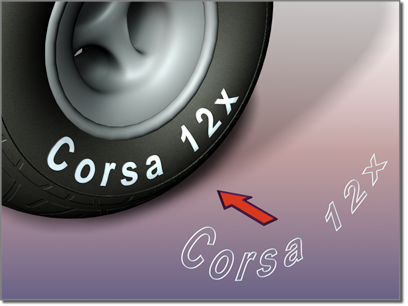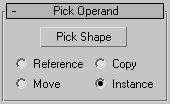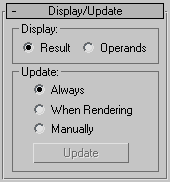ShapeMerge creates a compound object consisting of a mesh object and one or more shapes. The shapes are either embedded in the mesh, altering the edge and face patterns, or subtracted from the mesh.

ShapeMerge combines the lettering, a text shape, with the mesh that models the tire.
Procedures
To create a ShapeMerge object:
- Create a mesh object and one or more shapes
- Align the shapes in the viewport so they can be projected toward the surface of the mesh object.
-
 Select the mesh object, then click the ShapeMerge button.
Select the mesh object, then click the ShapeMerge button. - Click Pick Shape, and then click the shape.
The geometry of the surface of the mesh object is altered to embed a pattern matching that of the selected shape.
Interface
Pick Operand rollout

- Pick Shape
-
Click this button, and then click the shape you want to embed in the mesh object. The shape is projected onto the mesh object in the direction of the shape's local negative Z axis. For example, if you create a box, and then create a shape in the Top viewport, the shape is projected onto the top of the box. You can repeat this process to add shapes, and the shapes can be projected in different directions. Simply click Pick Shape again, and then pick another shape.
- Reference/Copy/Move/Instance
-
Lets you specify how the shape is transferred to the compound object. It can be transferred either as a reference, a copy, an instance, or moved, in which case the original shape is not left behind.
Parameters rollout

Operands group
- [list of operands]
- Lists all operands in the compound object. The first operand is the mesh object, and any number of shape-based operands can follow.
- Name
- If you select an object in the list, its name is displayed here. You can edit the field to change the object name.
- Delete Shape
- Remove selected shapes from the compound object.
- Extract Operand
- Extracts a copy or an instance of the selected operand. Choose an operand in the list window to enable this button.
- Instance/Copy
-
Lets you specify how the operand is extracted. It can be extracted either as an instance or a copy.
Operation group
These options determine how the shape is applied to the mesh.
- Cookie Cutter
-
Cuts the shape out of the mesh object's surface.
- Merge
-
Merges the shape with the surface of the mesh object.
- Invert
-
Reverses the effect of Cookie Cutter or Merge. With the Cookie Cutter option, the effect is obvious. When Invert is off, the shape is a hole in the mesh object. When Invert is on, the shape is solid and the mesh is missing. When you're using Merge, Invert reverses the sub-object mesh selection. As an example, if you merge a circle shape and apply a Face Extrude, the circular area is extruded when Invert is off, and all but the circular area is extruded when Invert is on.
Output Sub-Mesh Selection group
Provides options that let you specify what selection level is passed up the Stack. The ShapeMerge object stores all selection levels; that is, it stores the vertices, faces, and edges of the merged shape with the object. (If you apply a Mesh Select modifier and go to the various sub-object levels, you'll see that the merged shape is selected.) Thus, if you follow the ShapeMerge with a modifier that acts on a specific level, such as Face Extrude, that modifier will work properly.
If you apply a modifier that can work on any selection level, such as Volume Select or XForm, the options will specify which selection level is passed to that modifier. Although you can use a Mesh Select modifier to specify a selection level, the Mesh Select modifier considers the selection only at frame 0. If you've animated the shape operand, that animation will be passed up the Stack for all frames only by using the Output Sub-Mesh Selection options.
- None Outputs the full object.
- Face Outputs the faces within the merged shape.
- Edge Outputs the edge of the merged shape.
- Vertex Outputs the vertices defined by the spline of the shape.
Display/Update rollout

Display group
Determines whether the shape operands are displayed.
- Result Displays the result of the operation.
- Operands Displays the operands.
Update group
These options specify when the display is updated. Typically, you use them when you've animated the merged shape operands and the viewport display is slow.
- Always Updates the display at all times.
- When Rendering Updates the display only when the scene is rendered.
- Manually Updates the display only when you click the Update button.
- Update
-
Updates the display when any option except Always is chosen.